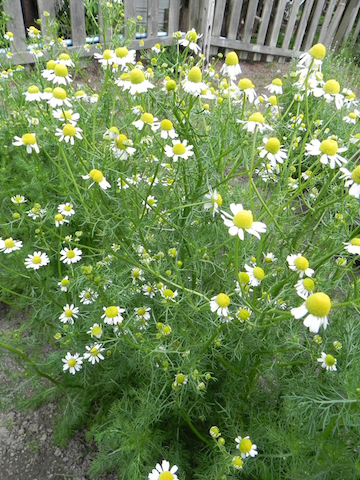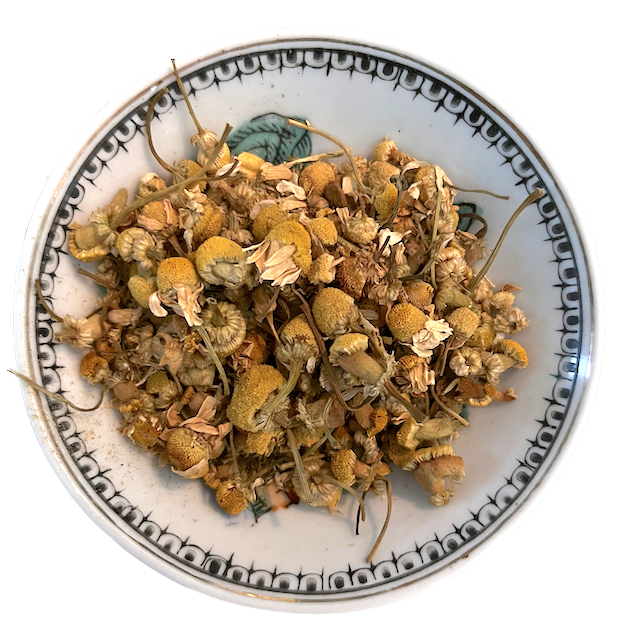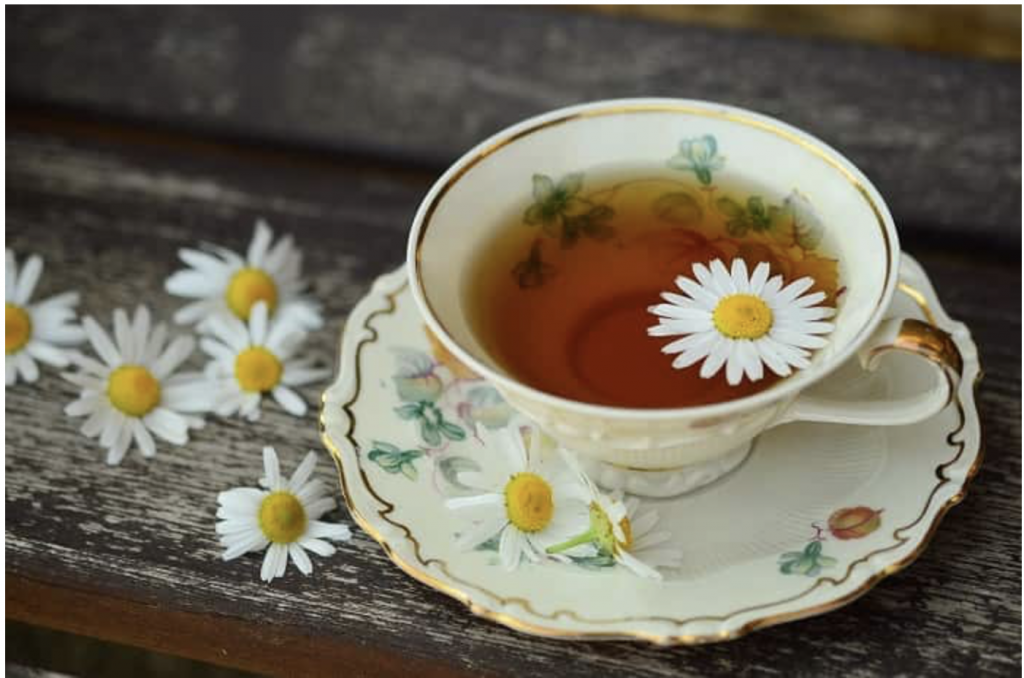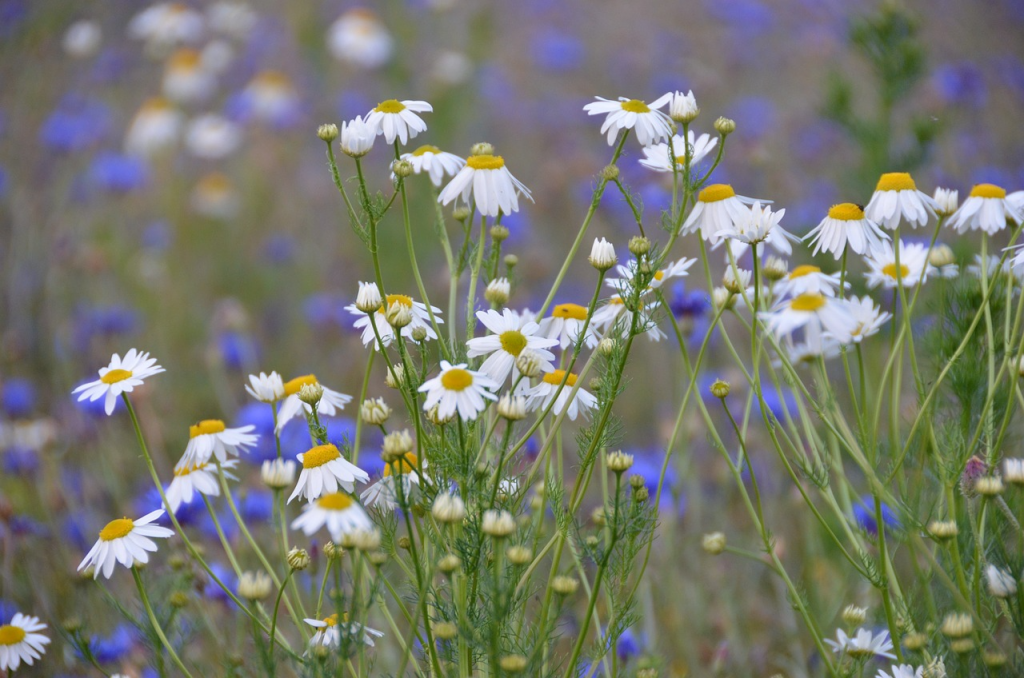
Chamomile is a delicate looking annual plant with a sweet, apple-like fragrance. It is mostly used for tea, but has other benefits as well. If I had to choose just one herb to have, I might very well choose Chamomile due to its many uses. Read on to learn more.
The ferny leaves and thin stems form a small bushy clump. The tiny flowers grow like little hats atop the stems. The plant reaches about 12″ – 15″ tall and then the little flowers start to form. Harvesting for tea can be somewhat tedious if you’re trying to harvest just the flowers, as the blossoms are so small.
I harvest Chamomile by gathering up a handful and snipping off the top 2″ – 4″ of the stem. I use the leaves as well as the flowers for tea. I’ve seen a hand held rake type tool used for manual harvesting, similar to a tool used to hand harvest blueberries.
The most common type of Chamomile used for tea is called German Chamomile, Matricaria chamomilla. There are other types of Chamomile. One is low growing and used for landscaping. It is generally known as Roman Chamomile, Chamaemelum nobile or, under it’s older botanical designation: Anthemis nobilis. Another type is Maroc Chamomile, Chamaemelum mixtum, formerly Anthemis mixta, Ormenis mixta.

The most common use for German Chamomile is for tea. It is a soothing, calming herb with a bright, sweet flavor. Harvest the flowers before they are fully open for best flavor. Dry them and store in an air tight container for future use. The flowers rehydrate easily, so be sure to keep air out of the storage container or your tea could form mold.
Historical uses for Chamomile include to calm upset stomach, soothe nervousness and anxiety and as a hair rinse for those with light or blond hair. A double strength tea sprayed on new seedlings has promise in combatting damping off disease- a fungal disease that attacks new seedlings and causes them to fall over and die. A strong Chamomile tea makes a soothing wound wash and a salve made from Chamomile infused oil acts to help cool rashes and even burns.
Chamomile is easy to grow from seed or transplants, if you can find them. It can grow in full sun to part shade with average water in well draining soil. The plant seems to be a good companion for cabbage and other brassicas since it strengthens the soil and keeps away pests. (Brassicas are notoriously heavy feeders.)
Where I live in South Central Texas, Chamomile is a cool season annual. It readily reseeds for me- it’s impossible to harvest “all” the flowers. I see the tiny seedlings in late winter or early spring. I get about 3 harvests from the plants, then it succumbs to the heat of our Texas summer.
In many places, you can grow Chamomile all summer long. Keep harvesting the flowers and you’ll keep getting more. Late in the season, start leaving some of the flowers to dry on the plant and drop. You’ll have a crop next year!
Warning
Some people who have seasonal allergies, especially to ragweed, may be allergic to Chamomile, since they are in the same Family, the Asteracea (or Compositae) Family. If you don’t know if you are allergic to Chamomile, use common sense and try a little bit to see if you have a reaction, before drinking a whole cup or two.
Chamomile Tea

Infuse 2 teaspoons of fresh, 1 teaspoon dried, Chamomile Flowers in a cup of freshly heated water for 10 minutes. Strain and enjoy!
Chamomile makes a lovely Iced tea as well as a hot tea. Make your brew double strength, strain it, add a little honey and/or lemon, if desired, while it’s hot, pour it over ice, stir it up and enjoy!
Chamomile acts as a mild diuretic, so you might not want to drink Chamomile Tea right before bedtime. To benefit from Chamomile’s relaxing and soothing properties before bedtime, try an extract (tincture) of Chamomile, rather than a cup of tea.
Herbal Digestive
- 1 Tbsp fresh chamomile
- 1 Tbsp chopped mint
- 1 Tbsp lemon verbena
- 1 Tbsp lemon balm or zest from 1 lemon (no pith)
- 2 cloves
- 1 stick cinnamon
- 1 Tbsp coriander (crushed seeds)
- 1 Tbsp lavender flowers
- 1/4 cup sugar
Place ingredients in mason jar and pour enough brandy to cover completely or fill mason jar. Steep 4-6 weeks, strain and decant into smaller bottles. Take by the dropperful after a heavy meal or if feeling bloated.
(The Madison Herb Society Cookbook)
Chamomile Wine
- 1 bottle dry white wine
- 1 cup dried chamomile flowers
- grated zest of 1 orange
- 1 1/2 oz light rum (optional)
- 4 Tbsp honey (or to taste)
Pour wine into a clean glass jar or bottle. Add chamomile, orange zest and rum. Cover and steep for 1 week. Strain through a coffee filter, add honey to taste and pour it into a clean container. Seal and store for up to 1 year.
(Herb Companion, Aug/Sept 2003)
Chamomile is popular in many cosmetic preparations such as shampoo and hair rinses, salves, skin toners and in a bath.
Body & Soul: Skin Soothing Chamomile Spray
By Janice Cox
Makes 8 ounces
German chamomile (Matricaria chamomilla) is easy to grow almost anywhere. This sweetly scented herb is an anti-inflammatory and antiseptic agent, helping to relieve the sting caused by too much sun or wind. You can make this skin-soothing recipe as easily as a cup of tea. (If you don t have chamomile flowers, you can make a spray from a few drops of chamomile essential oil mixed with a cup of water.)
1/2 cup fresh chamomile flowers
1 cup boiling water
In a ceramic container, pour the boiling water over the chamomile; steep for at least 1 hour. Strain out the flowers and pour liquid into a clean spray bottle or other container. To use, spray on clean skin or apply with a cotton pad. Let tea dry on your skin; do not rinse.
Janice Cox is the author of Natural Beauty from the Garden (Henry Holt and Company, 1999).
Chamomile Hair Rinse
By Janice Cox
Makes 12 ounces
This rinse is good for lightening fair hair.
2 cups water
1/4 cup fresh or dried chamomile flowers
1. Boil water and pour over chamomile flowers. Let mixture cool and then strain out all solids before using.
2. To use: Pour over clean hair as a final rinse. Do not rinse.
I leave. you with this lovely flower meadow including chamomile.

Until next time, say well and enjoy your herbs,
Cindy
